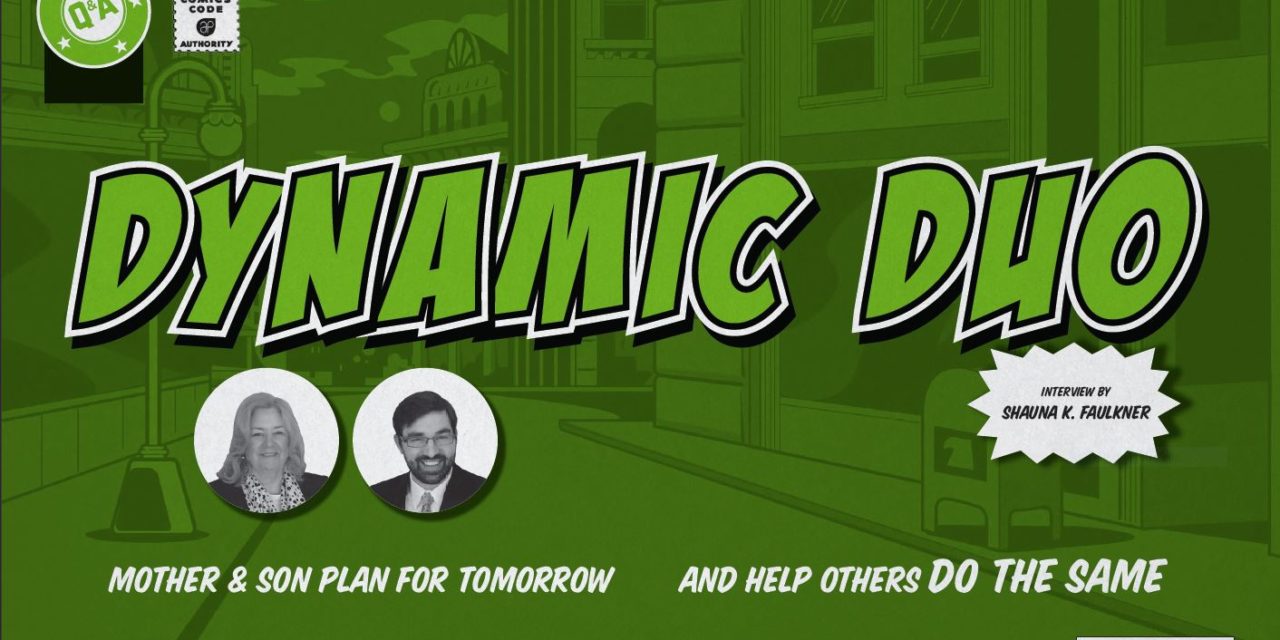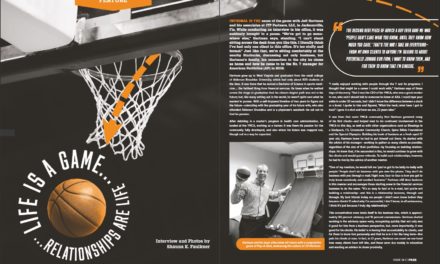
FREE 9.2 Q&A – Patricia McNeilly and Steven McNeilly
Patricia McNeilly of Glen Ridge, N.J. turned her 25-year career as a securities analyst into one where she could stand on her own, planning others’ financial futures. Her successful practice only grew in scope when her son, Steven, joined the firm in 2008. Now this dynamic duo is a leader in corporate retirement plans, building a reputation for retirement knowledge and sharing their expertise with other advisors. With an eye firmly on the future, Patricia and Steven are building a business model geared for success now, and limitless potential for years to come.
To view the full article please register below:
FREE 9.2 Q&A – Patricia McNeilly and Steven McNeilly
Dynamic Duo – Mother and son plan for tomorrow… and help others do the same.
Patricia McNeilly of Glen Ridge, N.J. turned her 25-year career as a securities analyst into one where she could stand on her own, planning others’ financial futures. Her successful practice only grew in scope when her son, Steven, joined the firm in 2008. Now this dynamic duo is a leader in corporate retirement plans, building a reputation for retirement knowledge and sharing their expertise with other advisors. With an eye firmly on the future, Patricia and Steven are building a business model geared for success now, and limitless potential for years to come.
FREE: Patricia, your career spans more than 35 years. Tell us what led you down the path to financial services.
PATRICIA MCNEILLY: I got into financial services because it was an area where women could have careers; that was in 1980. I earned my MBA in finance from NYU’s Stern School of Business and started in the industry as a securities analyst. Over the course of 25 years, I worked for some pretty major institutions like Solomon Brothers, S&P and Prudential. After a while, though, I realized I wanted something that allowed me more flexibility and to own my business while I was raising Steven. That’s how I made the switch from a securities analyst to financial planning. As a financial professional, I saw a tremendous need for financial planning and nobody was walking in the door to do it with me; so, I made that transition.
FREE: Steven, what about you? Was it a natural career path for you considering you grew up with a parent in the field?
STEVEN MCNEILLY: Well, I wouldn’t say it was natural; more that I was exposed to it. Patricia started the practice in 1998, right when I started high school. I didn’t get too involved in the business until college. I was an economics major, so going into financial services was one of the possible career tracks I could have taken. However, after I graduated college, I spent a year working, selling payroll services and being part of an Olympic development program in rowing. When my involvement with Olympic rowing ended, I really had to look at and decide if I wanted to continue in sales for the rest of my life. I disagreed with the company’s philosophy on how to view clients. There, the sales department wasn’t supposed to care about client service. It was all about sales. After landing a new client, I was advised not to take calls from clients unless there was an opportunity to sell them another service. At that point I started looking more into financial planning and applied to several different companies. For me, it was more about the opportunity to focus on people and really get involved with clients.
FREE: It’s obviously been a great fit after almost seven years.
SM: Well, I just sort of tried it out. It wasn’t necessarily something that I knew I wanted to do forever at only 24 or 25 years old; that evolved over time. Moreover, I began this career in September 2008. We all know what was happening in the industry at that time. But yes, I have come to really enjoy the work. The opportunity to work with my mother has been great; it allows me an ownership track that wasn’t available in other career paths.
FREE: Patricia, on your end, when did you decide to go independent once becoming a financial planner? What drew you to American Portfolios?
PM: I was working for an insurance company and all they wanted me to do was sell insurance; they hardly noticed I had money under management. It’s the way I think. No, I’m not a salesman for somebody else. I needed to be in a place where I could be in charge of my own destiny. So I made the switch in 2005 and joined American Portfolios. I’ve always done advisory business and I was really impressed with the advisory team, which, at the time, was headed by [Senior Vice President of Advisory Services] Tom LoManto. I continue to explore the new options that have developed in advisory throughout the years. I’m a big user of the Advisor’s Choice program. I’m also very happy with AP’s compliance. I can’t be in business if I’m not compliant, and they do a good job protecting me. That was, and continues to be, very important to me.
FREE: Your practice’s Web site provides a lot of information. Can you give us some background on the makeup of your business and how you operate?
SM: Essentially, Patricia is the overall manager of the business; she oversees everything. The division, as it stands now, is I’m responsible for everything that has to do with corporate retirement plans. That includes the prospecting, servicing and all other aspects of our corporate retirement plan business. When I joined in 2008, we didn’t have many 401(k) plans, so we made a decision that we were going to research and establish a comprehensive consultative process for corporate retirement plans, much in the same way we have on the individual side. That was the area I was going to grow into and specialize in—mainly because I wasn’t going to spend 20 or 25 years as a securities analyst, as Patricia had done. Patricia believed it was a good segment to go after because it would also lead to providing more introductions to individual clients.
PM: Steven’s career is going to be different than mine. We each have our specialties. Ultimately, we are both working towards helping people understand how Social Security works and how that can benefit them. The strategies used around Social Security can improve their wealth and help them so they don’t run out of money. We spend a lot of time helping people with that kind of decision on the individual side. We want to ease the worry that people feel when considering their money and the future.
SM: Absolutely. We are partners, but also different. I’m also responsible for backing up Patricia in any of the individual capacities. With my focus during the first five years solely on corporate retirement plans, I’m now branching out to the rest. Eventually, I will take over Patricia’s role and act as the manager of the entire business because I am the succession plan for our practice. There’s a lot to learn.
FREE: You’re really looking toward the future. That’s great. Can you tell us a bit more about your practice’s focus on retirement?
SM: Part of the prospecting that I do now includes partnering with other AP advisors to help them incorporate 401(k) plans into their business, as well as doing joint work with other advisors. That’s where it has developed over the past five or six years as a result of regulations. Many advisors just don’t want to be in the business at all because of the stringent requirements. That’s where I fit in.
PM: Changing regulation is pushing these kinds of requirements on the small plan sponsor. We have The Retirement Plan Solution, which is really designed to help participants save better. A lot of legislation is being pushed by the government through sponsors, and it’s happening on the individual side as well. If you read the paper or listen to the news today, President Obama and the Department of Labor are making some noise about the fiduciary rule around retirement assets.
SM: The Retirement Plan Solution is our answer to what we think the small plan marketplace is not receiving. It’s a process designed to bring simplicity, focus and balance to 401(k) plans, and to deliver successful retirement plan experiences for both the plan sponsor and the plan participant. The simplicity aspect is designed to take as much of the work off the plan sponsor’s plate and put it onto our plate. We then provide the information so the data can be easily understood and a decision can be made. Essentially, our solution allows the advisor to focus on working on their business, rather than working on their retirement plan. The balance is having a good integration of the 401(k) plan into the overall company plan. With The Retirement Plan Solution, we’re going after companiesthat have somewhere between 10 and 500 employees, and with less than $25 million in plan assets. We have identified that segment of the market as the least served, and have put together a solution to help service that market in the way we feel they should be served.
FREE: What is the process when you are first approached by a client?
SM: When a new client comes to us— whether via referral or prospecting—the first thing we do is conduct a very high level overview that tells them “this is who we are … this is what we do.” We let them know at the very first meeting that we’re interviewing them, but they are also interviewing us. The second time we convene there is an in-depth discovery process meeting. We talk about all of their goals and objectives. It’s an intensive, fact-finding process and a very data-centric meeting. During our third meeting, we circle back and present our plan and solutions to help get them where they want to be, and ask them to make a decision. Once they choose to come on board with us, another meeting is arranged to sign the necessary documents. About 45 days out from coming on board, an initial review is scheduled. We offer our clients four opportunities per year to meet with us and connect. From a philosophical perspective, we are financial advisors and consultants. So many different professionals call themselves financial advisors; we’ve found that doesn’t really give the client any real idea of what we actually do. What we have found to be successful in communicating the role we play and the value we bring in helping a client build wealth is to say that we are looking to become their family CFO. People understand what that means.
FREE: What is your approach to financial planning and in communicating with clients?
SM: We have a comprehensive holistic consulting viewpoint where our job is to inform our clients so they can make prudent financial decisions. Whether it’s with a 401(k) plan or a financial plan, the process that we go through with clients is pretty much the same on both sides. The techniques and strategies we employ may be different, but the process is the same. As for the clients, they are clients of the business, with one of us [Patricia or Steven] designated as the chief contact for every client.
PM: It’s important to us to have a lot of communication with clients. I see or talk to clients every quarter, and this is in addition to the technology marketing we do: e-mail blasts, videos and so on. We can’t let them think or feel that they are forgotten. That’s where most of our business comes from— those clients who feel they don’t have enough money and their advisor doesn’t care. I was shocked in 2008 when I heard that there were advisors who weren’t calling clients. With what was going on, I didn’t like calling clients either, but I reached out because when clients are concerned and things are in upheaval that’s when they need us most. That is our approach to service.
FREE: Who would you say your target client is?
SM: From the individual side, our target client has about $1 million in investable assets. But more than that, it’s about the relationship; we try to maintain that relationship with a favorable client-to-advisor ratio. It’s one of the standards we uphold in our business. Right now, we never exceed a ratio of about 100-to-1. That ratio, to us, is a key measurement of the kind of client service we want to provide.
FREE: What does the future hold in store as the practice changes? Do you have plans to adjust that ratio?
PM: The long-term goal is to build the practice and be well-recognized in retirement planning; that is, working with the corporate retirement plans and a select group of individuals. For the ratio, we’re looking to be closer to 50-to-1; I just don’t think that you can give really good service if you start doing more than that. Steven will continue to grow until he takes over, probably in about five to 10 years, though I don’t ever plan on a full retirement. I’ll still keep my hand in the mix and have some clients who I’ll help advise. I just won’t be doing it full time. As it is, all new clients are seen together, so everyone associates the business with both of us.
SM: My goal is to grow the practice at an aggressive rate, but as it continues to grow, I’d like to actually expand our team to be training new advisors. That’s definitely part of our plan. In maybe five years from now, instead of two advisors, I’d like to see five advisors with close to 200 clients; we’d have roughly 40 clients per advisor with the majority of the clients fitting the ideal client profile. We’re still defining the actual goals, though. Patricia tends to be the skeptic and I’m the optimist; we meet somewhere in the middle.
FREE: That brings us to another question. Many people try to separate the business from the personal. How do you both handle that, being mother and son, as well as business partners?
PM: With a business coach. It’s difficult to be a parent and child, much less to work together. It’s hard to leave work at the office and vice versa sometimes.
SM: It’s a constant challenge, but we’ve gotten better at it over the years. We’ve started to figure out what works and doesn’t work in terms of how we partner together; more specifically, what are our communication styles, how often should we communicate to our clients and how do we craft a consistent message. We’re continuing to learn, but how efficient we are in the way we work together is probably the key thing we look at; if either one of us is not making the best use of our time based on our agreed-upon areas of focus, then it will affect every single area of the practice. That’s part of the reason why we have a business coach to help us address that.
FREE: That’s very proactive! With the breadth of experience and knowledge you each have, you’ve become quite the dynamic duo. What advice would you give to a new generation looking to embark on this career path in current times?
PM: I really don’t think it’s so different than in the past. You better be adaptive and be able to acclimate to a business that is constantly changing. It’s probably one of the fastest changing businesses. Beyond that, you have to know what your business model is and adapt it to be successful. Those are the important pieces to succeed for anyone coming into this business.
SM: I would say for anyone thinking of entering this field, just make the move and do it. There’s enormous opportunity in our business for the next generation. In the next 10 to 15 years, there’s going to be an incredible need for new advisors. I would also tell them to do their due diligence with any company that they join and to know exactly why they want to work for them. As a young person coming into this profession, the chance to have ownership in something is unbelievable; just make sure the company has the values you’re seeking.
FREE: Sounds like fantastic advice. Thank you both for your insight into your business and the future of financial services.
SM: Absolutely.
PM: Thank you.












